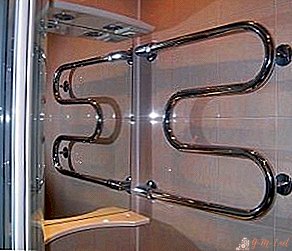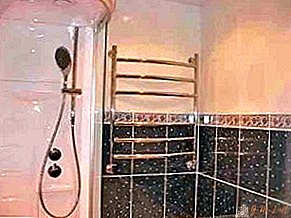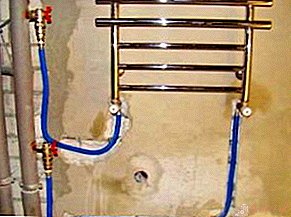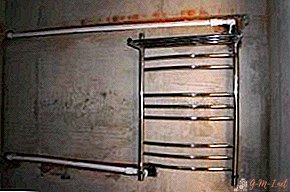 Bathroom - a room where there is always high humidity. In such rooms it is not customary to make heating, therefore heated towel rails come to the rescue. Thanks to them, the temperature rises and helps get rid of excess moisture, as well as make the stay in the bathroom more comfortable.
Bathroom - a room where there is always high humidity. In such rooms it is not customary to make heating, therefore heated towel rails come to the rescue. Thanks to them, the temperature rises and helps get rid of excess moisture, as well as make the stay in the bathroom more comfortable.
How to install a heated towel rail
To understand how to connect, you first need to study the types of heated towel rails.
So, there are four main groups:
- U-shaped. They are the simplest (side connection).
- The snake. Also one of the simple models that has a side connection.
- Ladder. This design consists of several side rails.
- Complex shape. Such dryers will decorate the interior due to its unusual shape. Connecting this device is very time-consuming, so you should seek help from a professional.

For the manufacture of PS such materials are used:
- copper;
- brass;
- stainless steel;
- steel.
Also, all towel dryers are divided into three types:
- Water.
- Electric.
- Combined.
What is required
For a high-quality installation of a dryer, you may need:
- The product itself.
- Brackets.
- PPR pipes.
- Knife for cutting PPR.
- Dowels.
- Bulgarian.
- Screwdriver.
- Wood screws.
- Two American 3⁄4.
- Screwdriver.
- Welding for PPR pipes.
- Two water sockets.
- Linen winding.
- Two cranes.
- PPR elbow with internal thread.
- Twelve pieces of polypropylene elbows.
- Combination coupling with internal thread.

Bottom connection variations
This variation has its advantages and disadvantages, let's talk about them.
The benefits include:
- Possibility to hide pipes under the shower or bathtub, so there is no need to wall the wall.
- For any feed direction in the riser, this option will work.
Minuses:
- Less effective when compared to side mounting.
- Air must be vented.
Necessary conditions for high-quality operation of substations:
- The top of the riser should be lower than the connection points.
- The angle of inclination of all pipes must be observed. It must be at least 3 mm per meter. It is recommended that the slope is not less than 30 mm per meter.
- The presence of humps is unacceptable, since as a result of this, air will accumulate inside and circulation will be disturbed.
- In order to ensure strong circulation, the diameter of the pipes should not be less than 3/4 ". It is permissible to use pipes with a smaller cross-section exclusively with a small length of pipes leading to the device, however, in this case, uneven heating can be noticeable.
- Thermal insulation should be made on all supply pipes to improve circulation.

Bypass installation
The basic rule is that it is categorically not recommended to install cranes on the bypass, because a blocked or overly narrowed bypass can lead to a number of negative consequences:
- Violations of the circulation of the riser.
- Deteriorating water pressure in all apartments.
- The quality of the heated towel rail with the lower connection will deteriorate.
The standard equipment includes:
- Mayevsky crane;
- silicone gaskets;
- locking nodes;
- transition corners;
- telescopic brackets.
Important! It is recommended that components made of the same material be used. This approach will help prevent electrolytic corrosion.
Before proceeding with the installation, you need to remove the old equipment. To do this, disconnect the riser from the water supply. Then:
- If the device is welded to the riser, then it must be cut off with a grinder.
- In the event that the PS is not one with the hot trunk, you just need to untwist the thread at the junction.
- Remove the obsolete dryer from the brackets.

Important! It is possible to mount the coil without installing a bypass, however, professionals strongly recommend making a jumper. Ball valves must be installed at the ends of the device. If the need arises, it is possible to shut off the supply of warm water, while in the riser it will continue to circulate.
To install the taps, it is necessary to cut a new thread on the remaining pipe sections. Then, put a tap on the finished pipes.
Dryer Mount
The procedure is as follows:
- The wall is marked for brackets.
- Holes are prepared into which dowels are inserted.
- The brackets are screwed to the PS, the device is attached to the wall and fixed thanks to screws.
- Through fittings, the unit must be connected to jumpers and valves. All connections must be strengthened with linen winding.
 The above installation method is universal. If the installation does not need to carry out welding work, then the installation can be done independently. However, before proceeding directly to the installation, one must correctly select both the dryer itself and the additional elements to it. With proper connection, the heated towel rail will serve for many years without any complaints.
The above installation method is universal. If the installation does not need to carry out welding work, then the installation can be done independently. However, before proceeding directly to the installation, one must correctly select both the dryer itself and the additional elements to it. With proper connection, the heated towel rail will serve for many years without any complaints.





Leave Your Comment